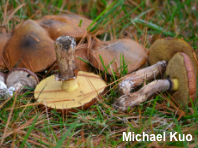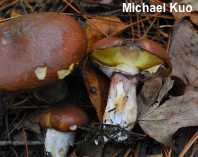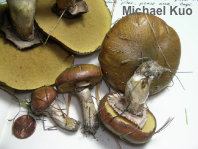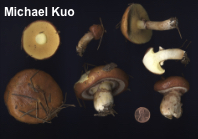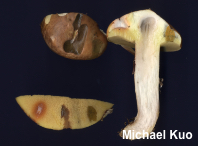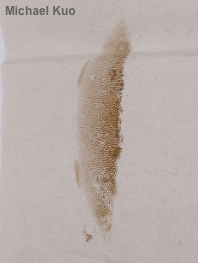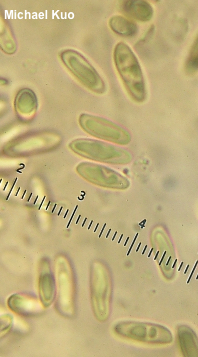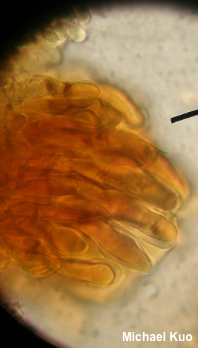| Major Groups > Boletes > Suillus > Suillus luteus |

|
[ Basidiomycota > Boletales > Suillaceae > Suillus . . . ] Suillus luteus by Michael Kuo, 26 December 2022 Whether 'tis nobler in the mind to suffer Yes, that is the question. You can pick the "Slippery Jack" (only one of those word is operative!)—or you can kick it, and all its slimy little friends, beat them all to a gooey pulp with your walking stick, smash them against trees, scream bloody murder at the top of your lungs . . . Excuse me. I was trying to say that Suillus luteus, which is the type species for the genus Suillus, is an impressive and beautiful fall mushroom, easily recognized by its stature, its glutinous brown cap, and its distinctive ring, which is white at first but soon develops purple shades. By its current definition (Nguyen et al. 2016) Suillus luteus is "the most widespread species [of Suillus] in the world." It is originally Eurasian, but has been introduced in many places across the globe. It is primarily associated with "hard" pines (those with needles bundled in groups of 2 or 3)—especially Scots pine and Austrian pine in Europe, and red pine in North America. However, the species as I know it from the Midwest is found not only under hard pines but also with eastern white pine, which is a "soft" pine with 5 needles. I am sure about this, having collected Suillus luteus numerous times under white pines in isolation, with no hard pines anywhere nearby. Thus, either Suillus luteus is capable of crossing the hard-soft pine breach, or there is a soft-pine-associated look-alike species. An array of color forms and varieties have been named in Europe, including albus, with a white cap; decolorans, with a pale brown cap that discolors whitish; and ochraceobrunneolus, with a brownish yellow cap. Thanks to Django Grootmyers for documenting, collecting, and preserving Suillus luteus for study; his collection is deposited in The Herbarium of Michael Kuo. Description: Ecology: Mycorrhizal with pines—especially with 2-needle pines like Scots pine and Austrian pine in Europe, and red pine in North America, but also with eastern white pine (see discussion above); growing gregariously; late summer and fall, or in winter during warm spells or in warm climates; originally described from Sweden (Linnaeus 1753) and neotypified from Sweden (Palm & Stewart 1986); widespread in Eurasia and North America; also reported from Central and South America, Oceania, and South Africa. The described and illustrated collections are from Illinois and Indiana. Cap: 4–10 cm across; convex when young, becoming broadly convex to nearly flat; thickly slimy when fresh; shiny when dry; bald; reddish brown to yellow-brown, sometimes with a darker brown center; fading to dull tan; often appearing radially streaked with darker pigments; when young with partial veil tissue often hanging from the margin. Pore Surface: Covered with a whitish partial veil when young; pale yellow, becoming yellow to brownish or grayish yellow with age; not bruising; with 2–4 round to angular pores per mm; tubes up to about 1 cm deep. Stem: 3–8 cm long; 1.5–2 cm thick; equal; bright to dull yellow toward the apex; dull yellow to whitish or brownish below; with prominent, cinnamon to brown glandular dots; occasionally without a persisting ring, but usually featuring an ample whitish ring that becomes purple to brown on the underside and eventually collapses against the stem; basal mycelium white. Flesh: White to pale yellow; not staining on exposure. Odor and Taste: Not distinctive. Chemical Reactions: Ammonia red, then slowly negative on cap surface; pinkish red on pore surface; pinkish red on flesh. KOH dark red to blackish on cap surface; dark brown on pore surface; dull purple to bluish on flesh. Iron salts negative to grayish or olive on cap surface; brown on pore surface; blue-gray on flesh. Spore Print: Cinnamon brown. Microscopic Features: Spores 6–10 x 2–2.5 µm; boletoid-fusiform; smooth; hyaline to dull yellowish in KOH. Basidia 18–22 x 4–6 µm; subclavate; 4-sterigmate. Cystidia sometimes rare but usually abundant, in gelatinized bundles, often obscured by pigment globules; 35–75 x 4–12 µm; cylindric to clavate or fusiform; thin-walled; smooth; brown in KOH. Pileipellis an ixocutis of poorly defined, gelatinized elements 2–4 µm wide, smooth, hyaline to brown in KOH. REFERENCES: (Linnaeus, 1753) H. F. A. de Roussel, 1796. (Coker & Beers, 1943; Singer, 1945; Smith & Thiers, 1964; Snell & Dick, 1970; Smith & Thiers, 1971; Smith, 1973; Thiers, 1975; Grund & Harrison, 1976; Phillips, 1981; Smith, Smith & Weber, 1981; Arora, 1986; Palm & Stewart, 1986; Breitenbach & Kränzlin, 1991; Phillips, 1991/2005; Schalkwijk-Barendsen, 1991; Lincoff, 1992; Both, 1993; Barron, 1999; Bessette, Roody & Bessette, 2000; Nonis, 2001; Roody, 2003; McNeil, 2006; Miller & Miller, 2006; Kuo, 2007; Buczacki et al., 2013; Klofac, 2013; Kuo & Methven, 2014; Bessette, Roody & Bessette, 2016; Nguyen et al., 2016; Siegel & Schwarz, 2016; Baroni, 2017; Gminder & Böhning, 2017; Kibby, 2017; Knudsen & Taylor, 2018; Noordeloos, 2018; Sturgeon, 2018; Læssøe & Petersen, 2019; Bianchi, 2020; MacKinnon & Luther, 2021; McKnight et al., 2021.) Herb. Kuo 11149402, 09299602, 10310405, 11120402, 11020901, 10241402, 11301501. This site contains no information about the edibility or toxicity of mushrooms. |
© MushroomExpert.Com |
|
Cite this page as: Kuo, M. (2022, December). Suillus luteus. Retrieved from the MushroomExpert.Com Web site: http://www.mushroomexpert.com/suillus_luteus.html |
